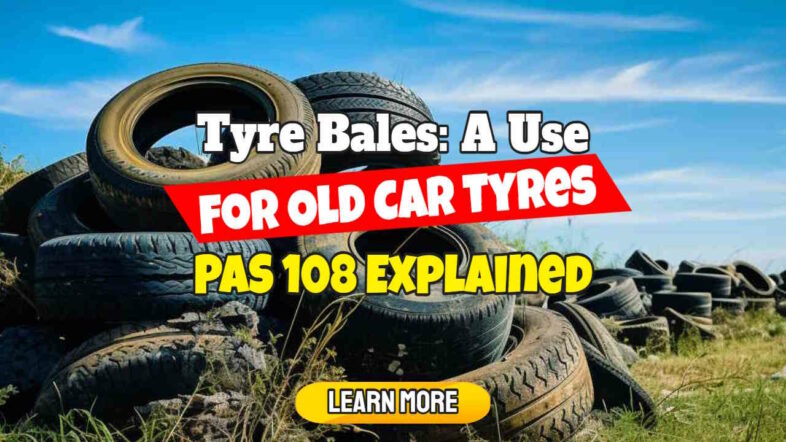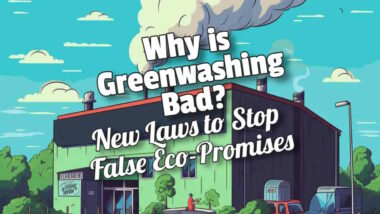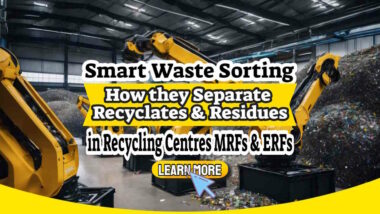Advantages of BSI PAS 108 Tyre Bales: A New Sustainable Use for a Problem Waste

A simple act by WRAP in 2008 revolutionised the use of tyre bales in UK civil engineering and landscape applications, sustainably using this material where otherwise resources would be wasted at their disposal.
It will be obvious to our Wastersblog waste management industry readers that the disposal of old vehicle tyres is generally a real headache. For the public, and as motorists, we are all feeling the pinch from rapidly rising tyre disposal costs.
Certainly, the last time I bought a new tyre, the garage added several pounds to my bill for disposing of the old one.
A number of landfill operators have been using whole tyres for leachate drainage within landfills for some years as an engineering material. The feedback we have received suggests that they have found that using tyres as drainage layers in landfills provides adequate flow capabilities, at close to zero cost for this “leachate drainage material”.
However, the number of tyres needed for this use is relatively small. It would not noticeably reduce the volume of worn-out tyres which need to be disposed of annually if all landfills were drained in this way.
Reusing whole tyres in alternative applications is hard manual labour. Imagine spending all day manhandling individual tyres to stack them efficiently! It’s a tedious, dirty, and time-consuming task. This fact alone has probably done a great deal to limit the uptake of tyre reuse.
It is true that granulated tyres have also been used for the purpose of leachate drainage. However, granulation is an energy-intensive process and requires the removal of the metal in tyres as well.
To re-use whole tyres, for landfill leachate drainage, was in the the past, as far as we are aware, just about the only “volume re-use” available.
But, now a whole new range of uses has been opened up by a new British Standard. That use is for whole-baled tyres. These are selected and baled in accordance with BSI PAS 108, the publicly available standard for Tyre Bales.
Since WRAP published this as a British Standards Institution (BSI) standard, and produced this Publicly Available Specification (PAS), in collaboration with the tyre reprocessing industry in 2008, the use has blossomed.
Almost overnight, due to the new standard “PAS 108 Tyre Bales”, baled tyres have become an engineering product with standard bale sizes and shapes, and most importantly, clear design strength data.
Designers and purchasers can now use the structural and drainage characteristics provided by the research done for the PAS, and incorporate tyre bales into their engineering designs, just like any other proprietary geosynthetic material.
In short, providing a specification for producing compact tyre bales of a consistent and verifiable quality and dimension, in “PAS 108 Tyre Bales”, has opened up a new and potentially huge market for waste tyres.
The method re-uses tyres sustainably when they are incorporated into engineering structures (such as the use in Pevensey for flood protection, as illustrated above). Such uses are sustainable, due to the reduction this use will have on the demand for the primary aggregate materials which are no longer needed. Primary aggregates are used in traditional gabion-walling. Gabion walling is the traditional way such walls were built in the past.
The important point here is that the “PAS 108 Tyre Bales” specification can be adopted by suppliers for producing tyre bales such that potential users of the bales will be assured that they are procuring a “construction material” or “product” of consistent and verifiable quality.
Furthermore, the core of this PAS document addresses the production, handling, storage, transport and placement of standardised tyre bales.
So, go find out more at the Landfill Site Tyre Bales page here, and you will also find the contact details for one of the first suppliers.
FAQ Section: Tyre Bales – A Revolutionary Use for Old Car Tyres – PAS 108 Explained
1. What are tyre bales?
Tyre bales are compacted blocks of discarded car tyres, typically bound together to form a solid structure. They are a sustainable solution for the vast numbers of waste tyres generated annually, and are often used in civil engineering projects.
2. How are tyre bales made?
Old car tyres are collected, cleaned, and then compressed under high pressure into large blocks. These blocks are then bound together using strong straps or wires to ensure their integrity and stability.
3. What is PAS 108?
PAS 108 is a specification for the production of baled end-of-life tyres (ELTs) for use in construction. It provides criteria that tyre bales must meet to ensure they are of consistent size, weight, and quality, suitable for various applications.
4. Why is PAS 108 important?
By adhering to the PAS 108 standard, producers and users of tyre bales can ensure they are receiving a consistent, high-quality product. This is crucial for the safety and effectiveness of projects that utilize these bales, such as retaining walls and erosion control.
5. What are the environmental benefits of using tyre bales?
Tyre bales offer several environmental benefits:
- Waste Diversion: They provide a means to divert a significant amount of waste tyres from landfills.
- Resource Conservation: Using waste tyres in construction minimizes the need for virgin resources, reducing environmental impact.
- Carbon Footprint: Repurposing tyres can reduce the carbon footprint associated with waste tyre disposal.
6. Where are tyre bales commonly used?
Tyre bales are versatile and have been used in a range of civil engineering applications. These include retaining walls, erosion control, road embankments, and as a substitute for traditional construction materials in certain projects.
7. How long do tyre bales last?
When used in construction, tyre bales can have a lifespan of many decades. Their durability largely depends on the specific application and the environmental conditions they are exposed to.
8. Are there any safety concerns with using tyre bales?
When tyre bales adhere to the PAS 108 standard, they are considered safe for use in various construction applications. However, like any construction material, they must be handled and installed correctly to ensure safety.
9. How does the cost of using tyre bales compare to traditional construction materials?
In many cases, tyre bales can be a cost-effective alternative to traditional construction materials. They not only divert waste from landfills but also can reduce transportation and material costs.
10. How can one ensure they are procuring PAS 108 compliant tyre bales?
Before purchasing, request certification or proof that the tyre bales meet the PAS 108 standard. Suppliers adhering to this standard will likely have undergone third-party assessments and will have the necessary documentation.
I hope this FAQ section addresses the most common questions readers might have about your topic. You can always modify and expand upon these questions based on feedback from your audience.
[Article originally posted on 14 November 2008. FAQs added August 2023.]






we will buy used tyres scrap